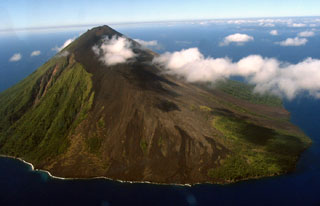Report on Lopevi (Vanuatu) — 23 April-29 April 2025
Smithsonian Institution / US Geological Survey
Weekly Volcanic Activity Report, 23 April-29 April 2025
Managing Editor: Sally Sennert.
Please cite this report as:
Global Volcanism Program, 2025. Report on Lopevi (Vanuatu) (Sennert, S, ed.). Weekly Volcanic Activity Report, 23 April-29 April 2025. Smithsonian Institution and US Geological Survey.
Lopevi
Vanuatu
16.507°S, 168.346°E; summit elev. 1413 m
All times are local (unless otherwise noted)
On 24 April the Vanuatu Meteorology and Geohazards Department (VMGD) reported that during the previous month seismic data confirmed continuing unrest at Lopevi. Small fumarolic steam plumes were continuously emitted at the summit crater based on webcam images from 1, 19, and 20 April. Low-level thermal anomalies were identified in satellite images on 6 and 20 April, indicative of increased surface temperatures. The Alert Level remained at 2 (on a scale of 0-4).
Geological Summary. The small 7-km-wide conical island of Lopevi, known locally as Vanei Vollohulu, is one of Vanuatu's most active volcanoes. A small summit crater containing a cinder cone is breached to the NW and tops an older cone that is rimmed by the remnant of a larger crater. The basaltic-to-andesitic volcano has been active during historical time at both summit and flank vents, primarily along a NW-SE-trending fissure that cuts across the island, producing moderate explosive eruptions and lava flows that reached the coast. Historical eruptions at the 1413-m-high volcano date back to the mid-19th century. The island was evacuated following major eruptions in 1939 and 1960. The latter eruption, from a NW-flank fissure vent, produced a pyroclastic flow that swept to the sea and a lava flow that formed a new peninsula on the western coast.
Source: Vanuatu Meteorology and Geohazards Department (VMGD)

